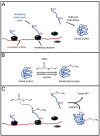Allicin: chemistry and biological properties
- PMID: 25153873
- PMCID: PMC6271412
- DOI: 10.3390/molecules190812591
Allicin: chemistry and biological properties
Abstract
Allicin (diallylthiosulfinate) is a defence molecule from garlic (Allium sativum L.) with a broad range of biological activities. Allicin is produced upon tissue damage from the non-proteinogenic amino acid alliin (S-allylcysteine sulfoxide) in a reaction that is catalyzed by the enzyme alliinase. Current understanding of the allicin biosynthetic pathway will be presented in this review. Being a thiosulfinate, allicin is a reactive sulfur species (RSS) and undergoes a redox-reaction with thiol groups in glutathione and proteins that is thought to be essential for its biological activity. Allicin is physiologically active in microbial, plant and mammalian cells. In a dose-dependent manner allicin can inhibit the proliferation of both bacteria and fungi or kill cells outright, including antibiotic-resistant strains like methicillin-resistant Staphylococcus aureus (MRSA). Furthermore, in mammalian cell lines, including cancer cells, allicin induces cell-death and inhibits cell proliferation. In plants allicin inhibits seed germination and attenuates root-development. The majority of allicin's effects are believed to be mediated via redox-dependent mechanisms. In sub-lethal concentrations, allicin has a variety of health-promoting properties, for example cholesterol- and blood pressure-lowering effects that are advantageous for the cardio-vascular system. Clearly, allicin has wide-ranging and interesting applications in medicine and (green) agriculture, hence the detailed discussion of its enormous potential in this review. Taken together, allicin is a fascinating biologically active compound whose properties are a direct consequence of the molecule's chemistry.
Conflict of interest statement
The authors declare no conflict of interests.
Figures











References
-
- Slusarenko A.J., Patel A., Portz D. Control of plant diseases by natural products: Allicin from garlic as a case study. Eur. J. Plant Pathol. 2008;121:313–322.
-
- Block E. Garlic and Other Alliums—The Lore and The Science. RSC publishing; Cambridge, UK: 2010.
-
- Koch H.P., Lawson L.D. Garlic: The Science and Therapeutic Application of Allium sativum L. and Related Species. Williams & Wilkins; Baltimore, MD, USA: 1996.
Publication types
MeSH terms
Substances
LinkOut - more resources
Full Text Sources
Other Literature Sources
Molecular Biology Databases

